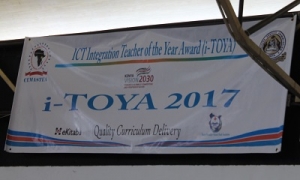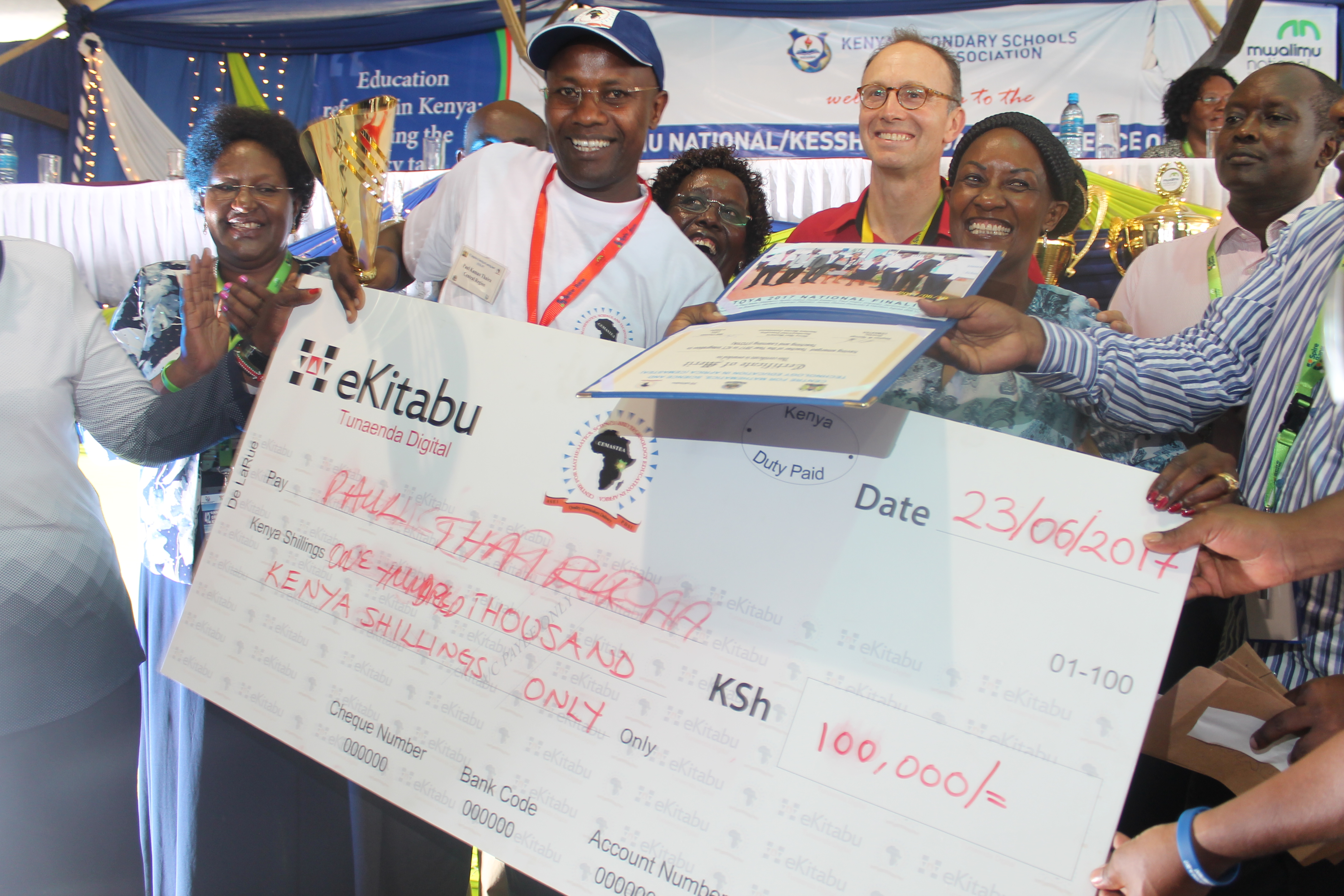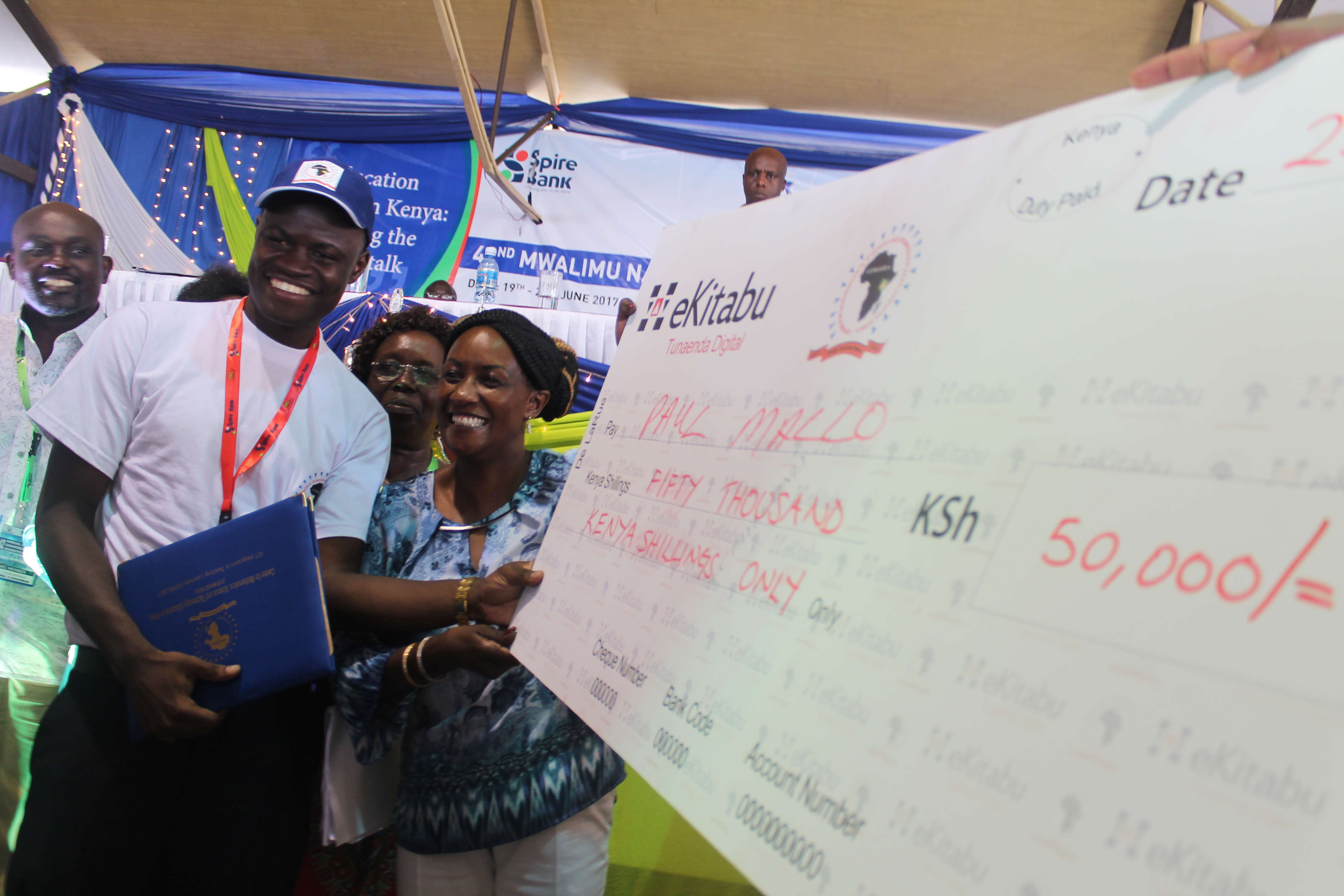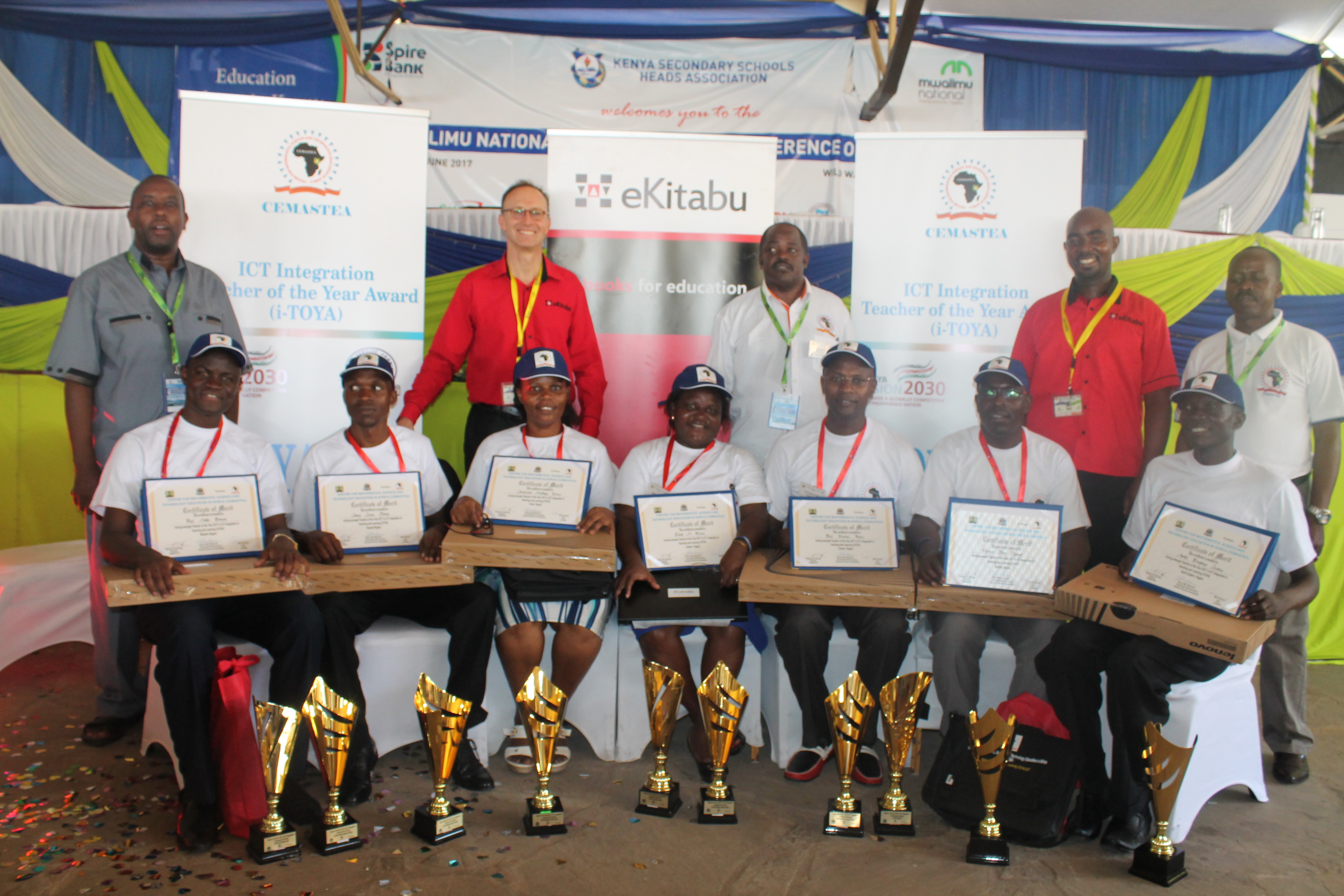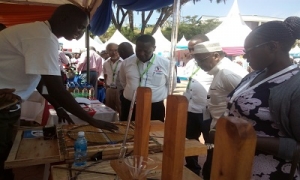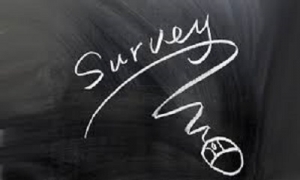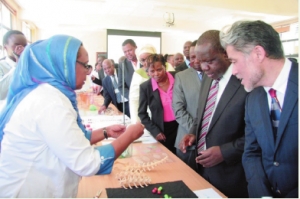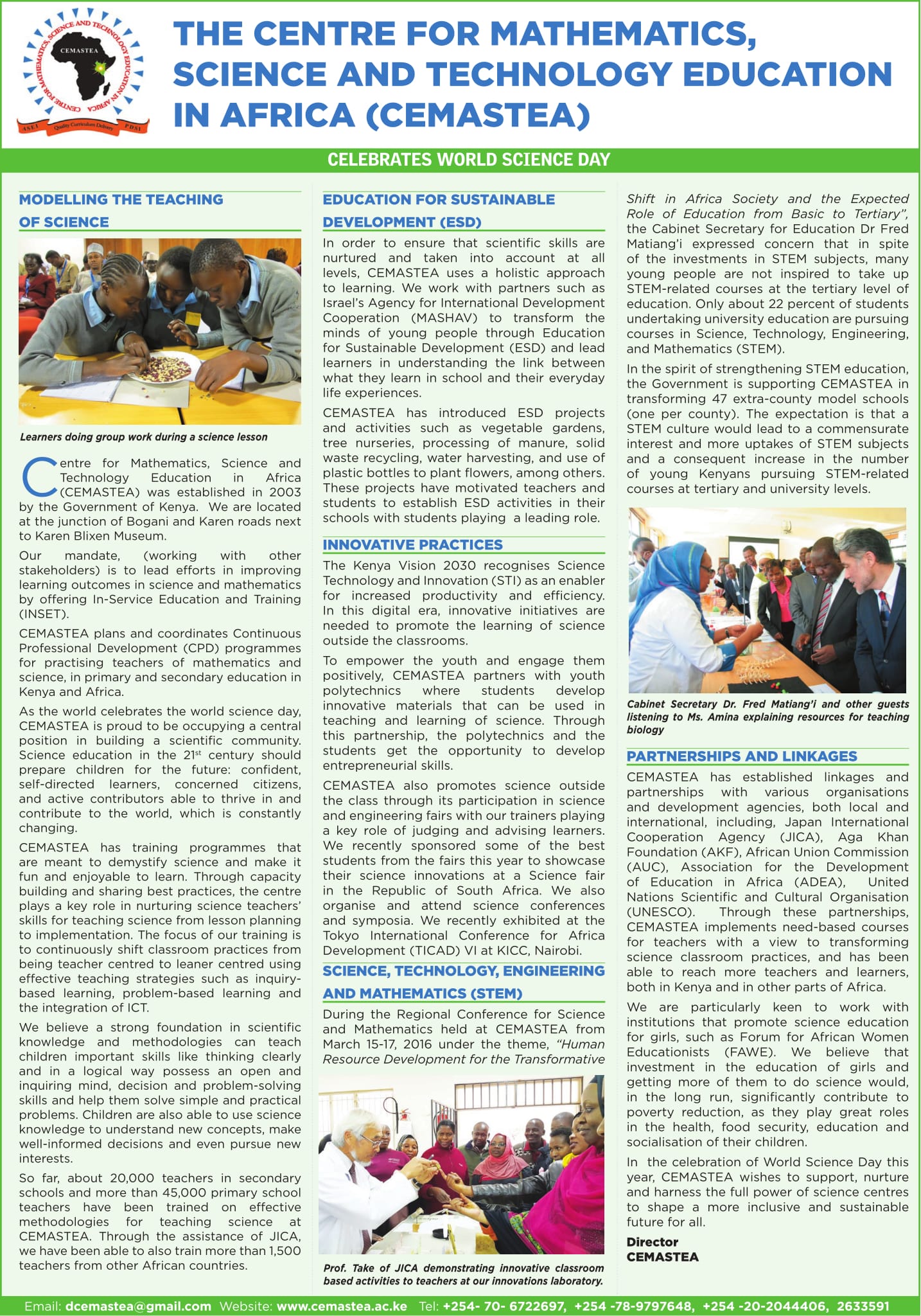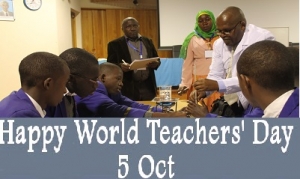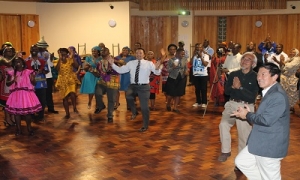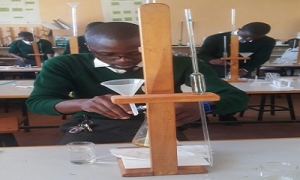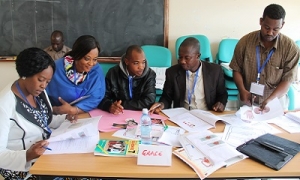CEMASTEA in conjunction with, e-Kitabu, TSC and KESSHA held a competition for the most innovative teacher who integrates ICT in teaching and learning. ICT Integrated Lesson Teacher of the Year Award (I-TOYA) held in Mombasa during the annual Kenya Secondary School Heads Association. The eight finalists were drawn from the eight regions namely; Nairobi, Coast region, Eastern region, North-Eastern region, Western region, Rift valley region, Central region and Nyanza region.
The Eight Regional Finalists
From left: Mr. Paul Mallo (Western), Appollo Justus (North Eastern), Mr. Paul Thairu (Central), Ms. Jemimmah Mutethya (Coast), Ms. Eunice Ruraa (Eastern), Mr. Harrison Onyango (Nairobi), James Okewa (Nyanza) and Mr. Harrison Agosa (Rift Valley)
This was the first time the i-TOYA competition was being held at the national levels alongside Teacher of the Year Award (TOYA) and Principal of the Year Award (POYA). The regional winners were subjected to an aptitude test before making their presentations in the presence of honorable Dr. Richard Belio Kipsang, Principal Secretary Education, Ministry of Education Science and Technology.
Richard Belio Kipsang, PS Education dance alongside PS State Department of Vocational Training Ministry of Education Dr Dinah Mwinziand Kenya Institute of Curriculum Development (KICD) Director Dr. Julius Jwan.
The presentations were done interchangeably with the TOYA and POYA which took most part of the day. The PS Education, Dr. Richard Belio Kipsang applauded the winners for the far they have reached in the competition and encouraged other teachers to incorporate the use of ICT tools and skills in teaching and learning. The presentation attracted many teachers from schools all over Kenya and i-TOYA regional winner got positive reactions on the good work they are doing to integrate ICT in their lesson.
Mr. Will Clurman, Co-Founder & CEO of e-Kitabu, one of the sponsors compared i-TOYA to a baby that has been born and will soon be running seeing the turn out of the 2017 competition taking into consideration its first time the competition is being held.
Mr. Will Clurman, Co-Founder & CEO of e-Kitabu with the National i-TOYA winners
The winner of the i-TOYA was Mr. Paul Kamau Thairu from Loreto Kiambu, Central region, who was awarded a laptop and Kshs. 100,000, first runners up was Ms. Eunice M. Ruraa from Kyeni girls, Eastern region who was also awared a laptop and Ksh. 70,000 and finally for second riunners up Mr. Paul Mallo Barasa, Lwanya secondary, western region was awarded a laptop and Kshs. 50,000.
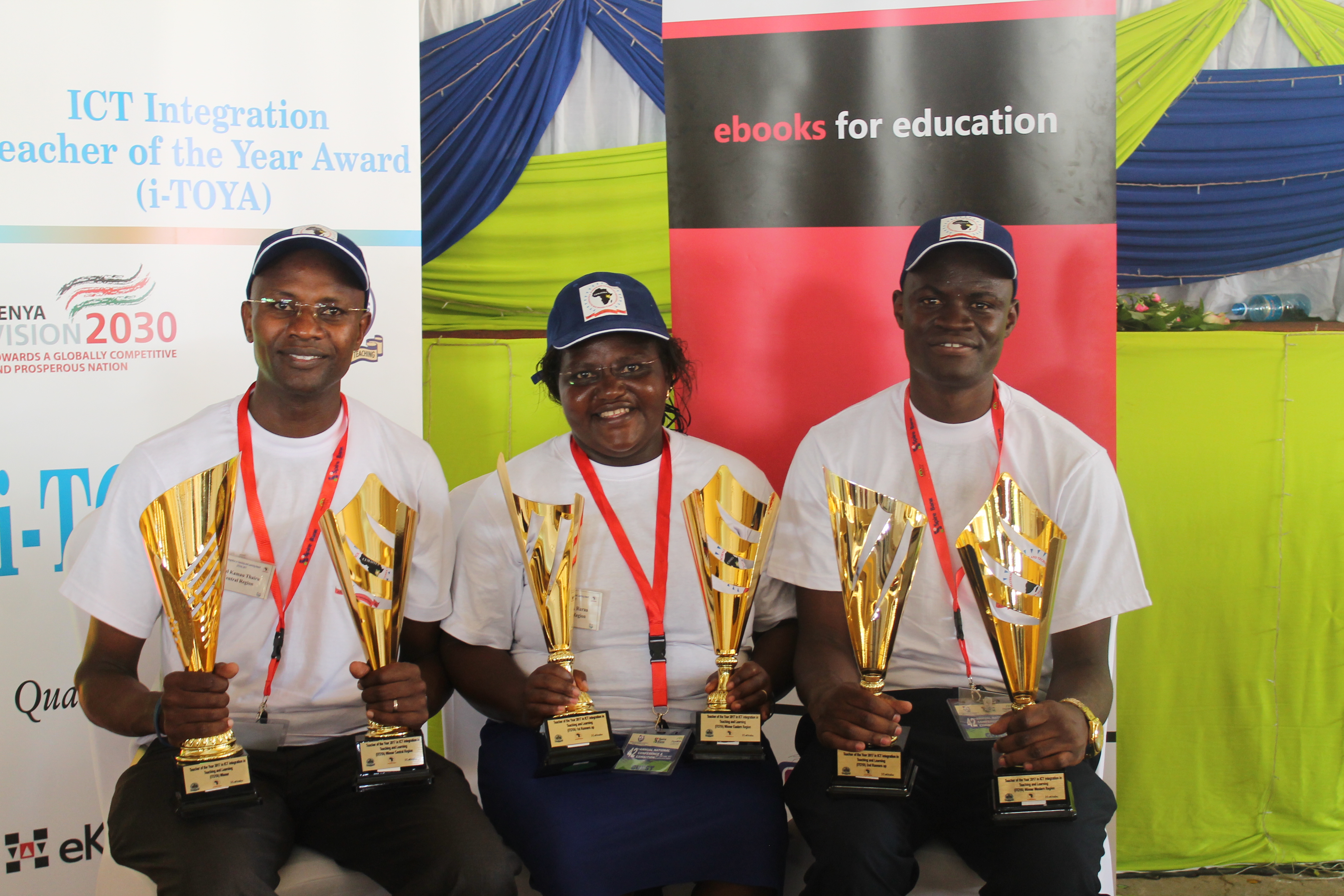
From right: Mr. Paul Kamau Thairu, winner i-TOYA, Ms. Eunice M. Ruraa, First runners up and Mr. Paul Mallo Barasa, Second runners up.
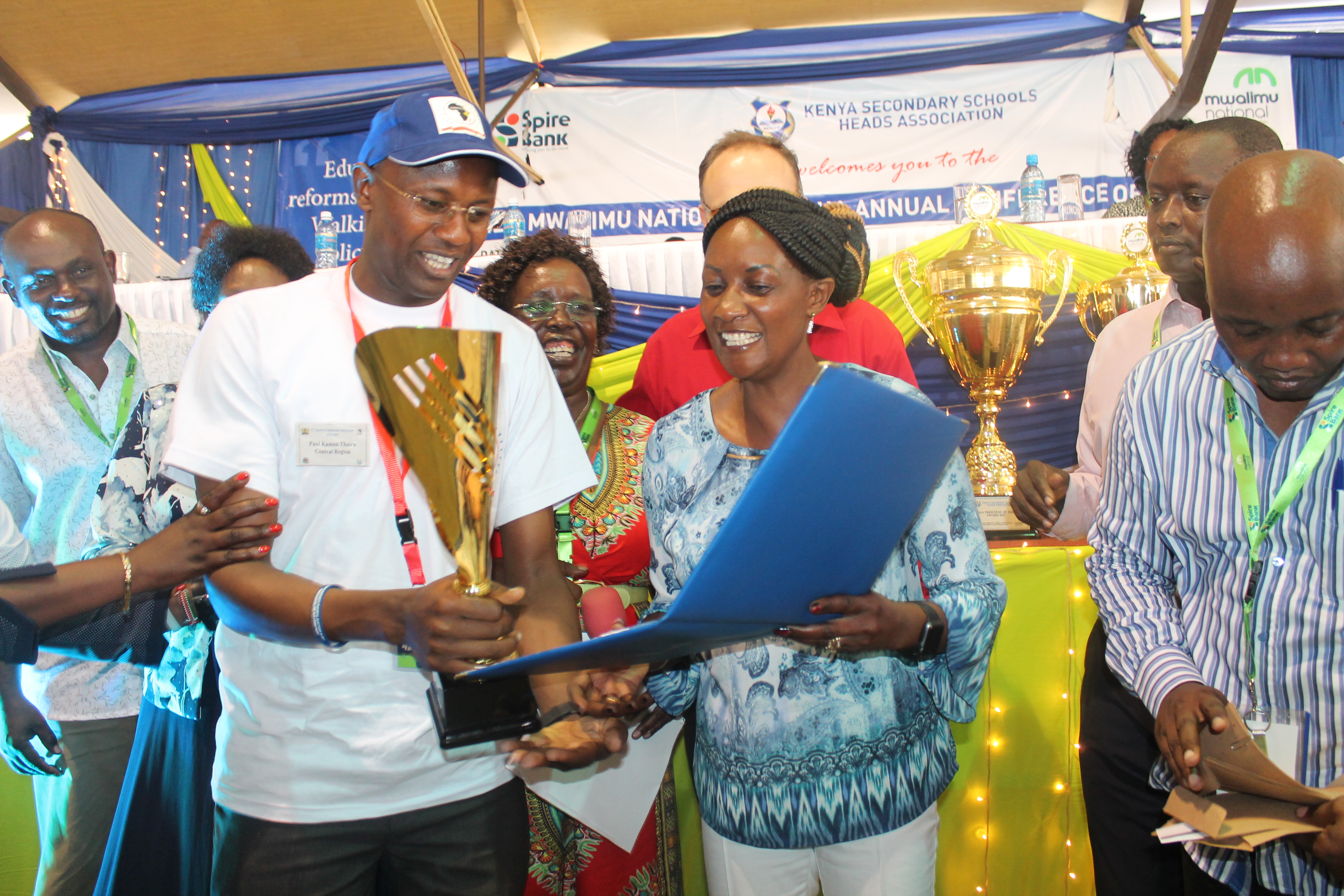
Mr. Paul Kamau Thairu, the Winner of i-TOYA, 2017

Ms. Eunice Ruraa, 1st Runners Up. Mr.Paul Mallo, 2nd Runners Up.
All the regional winners took home a Lenovo laptop, a gift bag and a regional trophy. The first i-TOYA 2017 competition started off very well and is planning for greater things years to come. Teachers are encouraged to register and participate for the upcoming i-TOYA 2018, and most of all to integrate ICT in their classroom.
i-TOYA 2017 Regional Finalist with Staff
The event started on the 19th to 23rd June 2017 at Wild Waters, Mombasa.
In the spirit of encouraging sharing innovations in schools, CEMASTEA supported three schools namely, Stephen Kositany Secondary School , Lenana High School and Garden Estate Secondary School. 
Mr Misoi Nicholas of Stephen Kositany Secondary School explaining to the Director CEMASTEA and other delegates how a Teaching Aid for the visually and hearing impaired in the topic; Trigonometric Ratios in Mathematics works.


An innovation demonstrating Bernauli’s Principle in Physics by Mr Anthony Nzuki of Lenana High School.

An innovation on Titration apparatus in Chemistry. A presentation by Garden Estate Secondary School.

The Director, CEMASTEA and some members of staff listening to a Physics video presentation on improvised activities in Electrostatics
Other CEMASTEA Innovations include:
Branding in Chemistry; Preservation of Veins in Plants (Biology);Clip Motor in Physics; Patterns and 3-D models in Mathematics .


The Centre for Mathematics, Science and Technology education (CEMASTEA) conducted a study to understand the process of selection of science subjects (i.e., biology, chemistry and physics) at Kenya Certificate of Secondary Education (KCSE) and factors influencing the selection in one of the counties in Kenya. The study involved principals of selected schools in the county, careers' masters and mistresses in the schools as well as science teachers and Form Three students. A total of 23 principals, 23 careers masters/mistress, 70 science teachers and 1081 Form Three students participated in the study. Data were collected from teachers and students through questionnaires and one-one interviews with principals and careers masters/mistress.
The findings of the study showed that:
- All the students who participated in this study take chemistry, 85% take biology and only 38% take physics. These findings are consistent with the statistics available from the Kenya National Examination Council (KNEC) on the candidature in these subjects. In most of the schools, students were not given opportunities to decide the science subjects to study. Rather, the subjects were taken based on what most principals and careers masters/mistresses referred to as "school policies" bluntly stated, "chemistry is compulsory in this school" or "chemistry and biology are compulsory" . Such “policies” left students with no option but abide.
- In some of the schools, students were asked to take no more than two science subjects. This was ensured through timetabling where two of the science subjects (i.e., biology and physics) were taught at the same time thereby inhibiting students from taking both subjects. Indeed, five schools were found not to have presented any candidates in physics at KCSE in 2-3 years preceding this study even when they had presented candidates in other subjects. Further examination of the data revealed that the students preferred to be left to decide the science subjects they would like to study and even some yearned for opportunities to study more than two science subjects where they were limited to taking only two science subjects.
- A number of factors were found to be influencing some schools to navigate away from physics as follows:
- Careers- most principals and careers masters stated that careers in science-related fields require chemistry.
- Resources- in some schools, inadequate resources especially laboratories, equipment and materials were cited as reasons for fewer students in physics.
- Personnel especially teachers- in terms of number and personal characteristics. For example, it was noted that some teachers discouraged students from taking physics.
- Performance in mathematics and physics- in some schools, it was noted that if students were perceived to be performing poorly in physics and/or mathematics, they would not be allowed to take physics.
These findings have implications for the attainment of goals of science and by extension Vision 2030. The low enrolment of students in physics may mean that the ability of some students to understand the natural world involving ideas in physics is greatly hampered. Consequently, getting a critical mass of human capital with sound understanding of physics concepts which, is requisite to economic and technological development, is negatively affected.
To mitigate this challenge, the Ministry of Education (MOE), needs to put in place a mechanism for sustained monitoring of schools for purposes of determining the level of implementation of MOE guidelines on selection of science subjects. In addition, CEMASTEA needs to sensitise science teachers and principals on their role in guiding students in the selection of science subjects. The MOE and/or BOM as is appropriate need to provide adequate resources to schools to enhance effective teaching and learning of all science subjects.
A colourful opening ceremony was recently held to kick off the ''Cultural Night'' at CEMASTEA; graced by TCTP 2016 participants from different region of Africa which included; Tanzania, Lesotho, Namibia, Zimbabwe, Botswana, Malawi, Swaziland and Uganda.


Opening dance
The MC Madam Priscilla Ombati started of the ceremony by welcoming everyone to the occasion and introduced the President of the programme, Madam Nesakya Juliet from Uganda who was very grateful on behalf of the participant for the warm stay at CEMASTEA and the efficient training they received form the national trainers.

Madam Priscilla Ombati, CEMASTEA Madam Nesakya Juliet from Uganda
(President of the TCTP Secondary programme)
The sugiyama hall was packed with an enthusiastic audience who enjoyed dances from various communities; the audience didn’t hesitate to join in the dances with occasional burst of laughter and cheering. The participants displayed their talent and well vast knowledge of their cultures and traditions.


BOTSWANA CULTURAL DANCE

LESOTHO CULTURAL DANCE


MALAWI CULTURAL DANCE

NAMIBIA CULTURAL DANCE

SWAZILAND CULTURAL DANCE

ZIMBABWE CULTURAL DANCE

TANZANIA CULTURAL DANCE

UGANDA CULTURAL DANCE
In addition, a cultural exhibition of traditional items was show cased which were exchanged among different people who attended the event as gifts.




Exchange of gifts photos
The cultural night lasted for about 2 hours, with music and drama performances staged by Third Country Training participants and finally ended with a traditional song led by Mr. Paul Lomosi, CEMASTEA. To top up the night, delicacies from different cultures were served and enjoyed late into the night.

Mr. Lomosi leading a luhya song'Mukangala'
Recult Burette Holder Is a unique holder innovation fully made of wood and which can hold almost all chemistry apparatus at once thus making it easy for the student to conduct his/her experiment without any hindrances. For more details see below;


Third Country Training Programme (TCTP) for primary schools was officially opened on
Monday, 19th September 2016.
The training is expected to run for a period of two weeks.
The countries represented are Ghana, Cameroon, Nigeria, Zambia, South Africa and Ethiopia.

The participants during the official opening ceremony
Other guests in attendance included Mr. Dina Mufti, The Ambassador of Ethiopia to Kenya and
Mr. Kazuhiro Tambara, a senior representative JICA office.
The objective of the training is to share ideas on Enquiry Based Learning (EBL) and Peer Education.
The Director, Mr. Stephen Njoroge in his speech, emphasized the importance of mathematics and science in innovation and urged the participants to make best of the training.

CEMASTEA Director, Mr. Stephen Njoroge addresses the participants
The chief guest, Director General in the Ministry of Education ,Science and Technology represented by Mr. Fidelis Nakhulo stated that teachers should be facilitators and not mere implementers of curriculum .He emphasized that teachers should aim at making a difference in mathematics and science.

Fidelis Nakhulo receives training materials to be used by the TCTP participants.
The 4th edition of e-Learning Innovations Conference Expo is a premier collaborative learning environment for educators, innovators, thought leaders, researchers. The conference is aimed at providing an opportunity to showcase cutting-edge research, innovation and contemporary e-learning practices.
CEMASTEA is currently participating in the on-going one week (Tuesday 13th to Friday 16th September, 2016) conference at Kenya Institute of Curriculum Development (KICD) in Nairobi, Kenya; NACECE Resource Centre.
Mr. Waibochi Paul and Esther Nyambura; CEMASTEA staff, will be presenting a paper on Digital Literacy Programme in Secondary Schools a CASE STUDY of CEMASTEA in line with the conference’s 2016 THEME: POWERING GROWTH / The International Conference For Mobile Educators, Researchers, Innovators, & Leaders.
The Aga Khan University, a partner of CEMASTEA, is a dynamic international and non-profit university with campuses in Kenya, Dar es Salaam, London, Uganda and Pakistan. The University offers courses such as nursing, education, communication and human development among others.
The Dar es Salaam Campus in Tanzania, contributes to the socio-economic development by improving the quality of education hence, conducts a broad array of academic and training programmes for in-service teachers, teacher educators, education managers and administrators from both the public and the private sectors. This is aimed at replacing traditional methods of rote learning with a student-centered approach that builds problem-solving skills and encourages independent thinking.
In 2016, the university in collaboration with CEMASTEA has been conducting a 5 month -three phased certificate course in mathematics and scientific literacy education for early grade teachers from Kwale County.
Phase one was a face-to-face interaction which ran for two weeks in April. The second phase entailed lesson observations and Saturday seminars which ran from May to July. The third and last phase was a face-to-face interaction which ran for two weeks in August and September.
The teachers were mainly involved in various training sessions that saw their participation in group presentations as well as induction by CEMASTEA staff.

CEMASTEA staff together with the teachers in a laboratory session.

The Director, Mr. Stephen M. Njoroge together with CEMASTEA trainers and participants from Kwale County.

